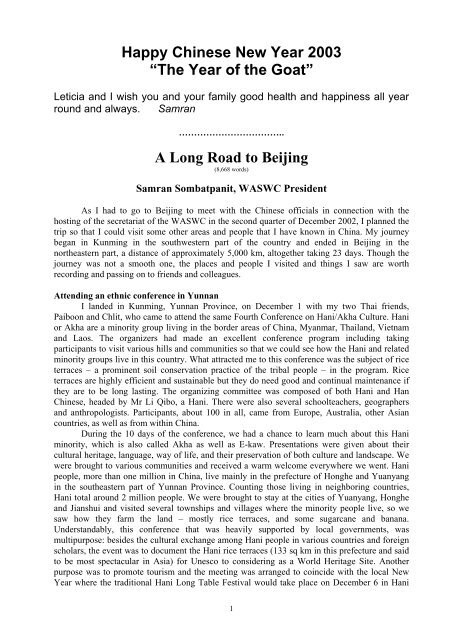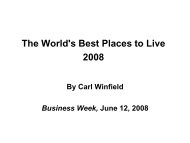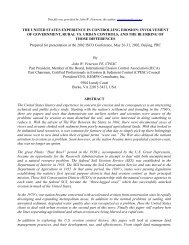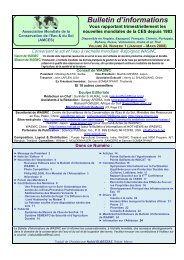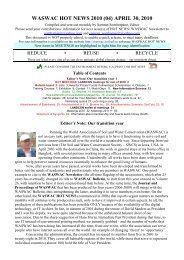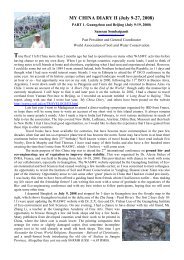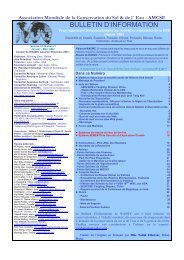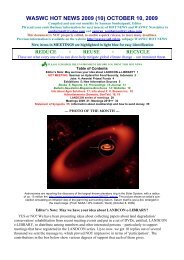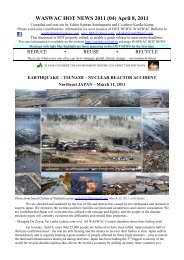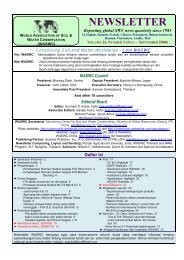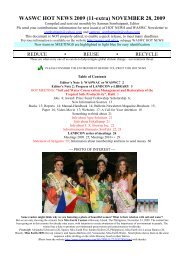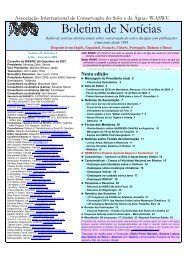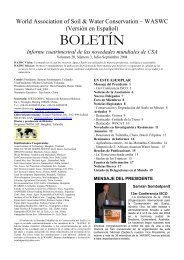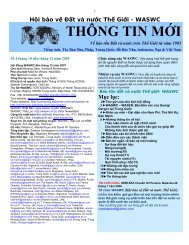A Long Road to Beijing - World Association of Soil and Water ...
A Long Road to Beijing - World Association of Soil and Water ...
A Long Road to Beijing - World Association of Soil and Water ...
You also want an ePaper? Increase the reach of your titles
YUMPU automatically turns print PDFs into web optimized ePapers that Google loves.
Happy Chinese New Year 2003“The Year <strong>of</strong> the Goat”Leticia <strong>and</strong> I wish you <strong>and</strong> your family good health <strong>and</strong> happiness all yearround <strong>and</strong> always. Samran……………………………..A <strong>Long</strong> <strong>Road</strong> <strong>to</strong> <strong>Beijing</strong>(8,668 words)Samran Sombatpanit, WASWC PresidentAs I had <strong>to</strong> go <strong>to</strong> <strong>Beijing</strong> <strong>to</strong> meet with the Chinese <strong>of</strong>ficials in connection with thehosting <strong>of</strong> the secretariat <strong>of</strong> the WASWC in the second quarter <strong>of</strong> December 2002, I planned thetrip so that I could visit some other areas <strong>and</strong> people that I have known in China. My journeybegan in Kunming in the southwestern part <strong>of</strong> the country <strong>and</strong> ended in <strong>Beijing</strong> in thenortheastern part, a distance <strong>of</strong> approximately 5,000 km, al<strong>to</strong>gether taking 23 days. Though thejourney was not a smooth one, the places <strong>and</strong> people I visited <strong>and</strong> things I saw are worthrecording <strong>and</strong> passing on <strong>to</strong> friends <strong>and</strong> colleagues.Attending an ethnic conference in YunnanI l<strong>and</strong>ed in Kunming, Yunnan Province, on December 1 with my two Thai friends,Paiboon <strong>and</strong> Chlit, who came <strong>to</strong> attend the same Fourth Conference on Hani/Akha Culture. Hanior Akha are a minority group living in the border areas <strong>of</strong> China, Myanmar, Thail<strong>and</strong>, Vietnam<strong>and</strong> Laos. The organizers had made an excellent conference program including takingparticipants <strong>to</strong> visit various hills <strong>and</strong> communities so that we could see how the Hani <strong>and</strong> relatedminority groups live in this country. What attracted me <strong>to</strong> this conference was the subject <strong>of</strong> riceterraces – a prominent soil conservation practice <strong>of</strong> the tribal people – in the program. Riceterraces are highly efficient <strong>and</strong> sustainable but they do need good <strong>and</strong> continual maintenance ifthey are <strong>to</strong> be long lasting. The organizing committee was composed <strong>of</strong> both Hani <strong>and</strong> HanChinese, headed by Mr Li Qibo, a Hani. There were also several schoolteachers, geographers<strong>and</strong> anthropologists. Participants, about 100 in all, came from Europe, Australia, other Asiancountries, as well as from within China.During the 10 days <strong>of</strong> the conference, we had a chance <strong>to</strong> learn much about this Haniminority, which is also called Akha as well as E-kaw. Presentations were given about theircultural heritage, language, way <strong>of</strong> life, <strong>and</strong> their preservation <strong>of</strong> both culture <strong>and</strong> l<strong>and</strong>scape. Wewere brought <strong>to</strong> various communities <strong>and</strong> received a warm welcome everywhere we went. Hanipeople, more than one million in China, live mainly in the prefecture <strong>of</strong> Honghe <strong>and</strong> Yuanyangin the southeastern part <strong>of</strong> Yunnan Province. Counting those living in neighboring countries,Hani <strong>to</strong>tal around 2 million people. We were brought <strong>to</strong> stay at the cities <strong>of</strong> Yuanyang, Honghe<strong>and</strong> Jianshui <strong>and</strong> visited several <strong>to</strong>wnships <strong>and</strong> villages where the minority people live, so wesaw how they farm the l<strong>and</strong> – mostly rice terraces, <strong>and</strong> some sugarcane <strong>and</strong> banana.Underst<strong>and</strong>ably, this conference that was heavily supported by local governments, wasmultipurpose: besides the cultural exchange among Hani people in various countries <strong>and</strong> foreignscholars, the event was <strong>to</strong> document the Hani rice terraces (133 sq km in this prefecture <strong>and</strong> said<strong>to</strong> be most spectacular in Asia) for Unesco <strong>to</strong> considering as a <strong>World</strong> Heritage Site. Anotherpurpose was <strong>to</strong> promote <strong>to</strong>urism <strong>and</strong> the meeting was arranged <strong>to</strong> coincide with the local NewYear where the traditional Hani <strong>Long</strong> Table Festival would take place on December 6 in Hani1
<strong>to</strong>wnships <strong>and</strong> villages. We were brought <strong>to</strong> a <strong>to</strong>wnship perched on a high hill overlookingHonghe City, <strong>to</strong> join the festival where around 600 dinner tables were aligned continuouslyalong the main street, all being covered with traditional Hani food, with thous<strong>and</strong>s <strong>of</strong> localpeople <strong>and</strong> guests enjoying their dinner. Hani <strong>and</strong> other ethnic minorities music was played asentertain.The hospitality <strong>of</strong> people <strong>of</strong> China is legendary indeed <strong>and</strong> we were treated very well forthese 10 days. At the end <strong>of</strong> the conference I gave a short talk about terraces. I mentioned thatthe terraces were presented at this meeting mostly as part <strong>of</strong> Hani culture, <strong>to</strong> be an importantmedium for <strong>to</strong>urism development. I mentioned the example <strong>of</strong> the rice terraces <strong>of</strong> Banaue in thePhilippines <strong>and</strong> the effects <strong>of</strong> <strong>to</strong>urism – large number <strong>of</strong> farmers are now working <strong>to</strong> earn moneyfrom <strong>to</strong>urism <strong>and</strong> do not have time <strong>to</strong> maintain the structures. As a result, many terraces havecrumbled. I recommended that they visit the Philippines <strong>and</strong> find out the pros <strong>and</strong> cons as thePhilippines opened up their terraces for <strong>to</strong>urism more than 40 years ago. I also suggested thatresearchers from agricultural university should be invited <strong>to</strong> study the agronomic, pedologic <strong>and</strong>conservation aspects <strong>of</strong> these terraces.This conference was very memorable <strong>and</strong> will be long remembered. All organizingcommittee members were very well informed <strong>and</strong> helpful. The sight that will remain with me fora long time came when we arrived at Yuanyang City on December 2. There were around 1,000locals dressing in their colorful traditional costumes lining up from the city gate <strong>to</strong> the cityproper <strong>to</strong> welcome us. Musicians played very lively tunes on traditional instruments <strong>and</strong> the restdanced, meanwhile several beautiful girls <strong>of</strong>fered us rice wine from bamboo cups. Music <strong>and</strong>dance were performed on several occasions during the conference. As for the subject itself, I feelChina has progressed well in the human rights. All 56 minority groups <strong>of</strong> China are considered‘citizens’ <strong>of</strong> the country, unlike some adjoining countries, for example Thail<strong>and</strong>, that regardtribal people as ‘illegal immigrants’. It will take a very long time for Hani/Akha in thosecountries <strong>to</strong> enjoy the privileges <strong>of</strong> legally being part <strong>of</strong> a country’s population.It was announced at the end that the Fifth Conference on Hani/Akha Culture will takeplace in Kengtung, Myanmar from December 27, 2005 <strong>to</strong> January 6, 2006.Visiting Yunnan Agricultural UniversityMy Thai colleagues <strong>and</strong> I were brought back <strong>to</strong> the city <strong>of</strong> Kunming on December 10after having traveled in the hills <strong>of</strong> SE Yunnan for about 1,000 km. We said good bye <strong>to</strong> theorganizers <strong>and</strong> other participants <strong>and</strong> went with Pr<strong>of</strong> Wu Bo Zhi (a WASWC member) <strong>to</strong>Yunnan Agricultural University where he is teaching soil <strong>and</strong> water conservation while alsoholding the post <strong>of</strong> the Dean <strong>of</strong> the Academic Division. The main purpose <strong>of</strong> this short visit was<strong>to</strong> finish the WOCAT questionnaires on the interesting SWC measure called ‘polythene mulch’that is now practiced by around one million Yunnan farmers, not counting those in otherprovinces. This practice involves the use <strong>of</strong> thin plastic sheets <strong>to</strong> cover the ground around thecash-generating crops. There are many benefits pertaining <strong>to</strong> it, so the government subsidizes itsuse, but farmers have <strong>to</strong> pay a part <strong>of</strong> the cost <strong>to</strong>o. The use <strong>of</strong> it had attracted the attention <strong>of</strong> theEU <strong>and</strong> Pr<strong>of</strong> Wu has been <strong>of</strong>fered funding <strong>to</strong> carry out research on this subject.We stayed at the guesthouse <strong>of</strong> the university for two days, during which time we had achance <strong>to</strong> visit <strong>and</strong> discuss things with academics <strong>of</strong> the university including President ChenHairu, about the possibility <strong>of</strong> some joint projects involving the exchange <strong>of</strong> scientists withThail<strong>and</strong>, especially from Chiang Mai University, <strong>and</strong> other countries. And we went <strong>to</strong> visit DrHuang Bizhi at the Yunnan Beef Cattle <strong>and</strong> Pasture Research Centre. Dr Huang, anotherWASWC member <strong>and</strong> a principal coopera<strong>to</strong>r <strong>of</strong> Pr<strong>of</strong> Wu in the EU polythene mulch project,explained <strong>to</strong> us the importance <strong>of</strong> the pasturel<strong>and</strong> around the city <strong>of</strong> Kunming, located some2,000 m asl, <strong>and</strong> which is considered the best in Yunnan. The Research Centre belongs <strong>to</strong> thePasture Research Institute, one <strong>of</strong> the six <strong>of</strong> the Yunnan Agriculture Department. Nearby, thereis one farm that raises pigeon for meat, a popular food in this Chinese province.2
We had a chance <strong>to</strong> look around Kunming <strong>and</strong> found that this city <strong>of</strong> 3 million people hasa lot <strong>to</strong> <strong>of</strong>fer <strong>to</strong> visi<strong>to</strong>rs. This is the capital <strong>and</strong> is located near the center <strong>of</strong> the province <strong>of</strong>Yunnan. Yunnan is considered the most exotic province <strong>of</strong> China, with large number <strong>of</strong> minorityethnic groups (25 <strong>of</strong> the 56 groups <strong>of</strong> China). It has a diversity <strong>of</strong> l<strong>and</strong>scapes with a karst<strong>to</strong>pography. It has high mountains going up <strong>to</strong> 6,740 m with snow cover all year round.Interestingly, many important rivers in this region flow through Yunnan, such as the Salweenflows <strong>to</strong> Myanmar, the Mekong <strong>to</strong> Myanmar, Laos, Thail<strong>and</strong>, Cambodia <strong>and</strong> Vietnam, the RedRiver <strong>to</strong> Vietnam, <strong>and</strong> the Yangtze <strong>to</strong> the East China Sea. Earlier in the year I came <strong>to</strong> Yunnanwith some Thai friends <strong>and</strong> found the province <strong>to</strong> be very interesting in several aspects <strong>and</strong>thought that, with the present open-country policy <strong>of</strong> the Chinese government, there is a grea<strong>to</strong>pportunity for <strong>to</strong>urists <strong>and</strong> travelers alike <strong>to</strong> visit <strong>and</strong> learn about this great country. Kunming isthe southwestern gateway <strong>of</strong> China. Yunnan has an area little more than three-fourths that <strong>of</strong>Thail<strong>and</strong>.Visiting the Guizhou Academy <strong>of</strong> Agricultural SciencesMy two Thai friends departed for home but I continued my journey <strong>to</strong> Guiyang by trainon the evening <strong>of</strong> December 12. Before Pr<strong>of</strong> Wu saw me <strong>of</strong>f at the Kunming railway station foran 11-hour train ride, he <strong>of</strong>fered me a large bowl <strong>of</strong> the ‘cross-bridge rice noodle’, a kind <strong>of</strong>noodles with long his<strong>to</strong>ry <strong>and</strong> one <strong>of</strong> the best-known dishes <strong>of</strong> Kunming <strong>and</strong> Yunnan.On December 13, upon my arrival in Guiyang City, the capital <strong>of</strong> Guizhou Province, Pr<strong>of</strong>Chen Xuhui, a pr<strong>of</strong>essor emeritus <strong>of</strong> the Guizhou Academy <strong>of</strong> Agricultural Sciences (GAAS),drove me <strong>to</strong> Luodian, a county close <strong>to</strong> the border with Guangxi Au<strong>to</strong>nomous Region. Along the200-km distance we passed through the beautiful karst l<strong>and</strong>scape, with streams flowing slowlythrough cone-shaped limes<strong>to</strong>ne mountains. One major stream from this area flows throughGuangxi <strong>and</strong> Guangdong, <strong>to</strong> become the river Pearl that empties in<strong>to</strong> the South China Sea afterpassing through Guangzhou, the third largest city <strong>of</strong> China.We went <strong>to</strong> the soil conservation on sloping l<strong>and</strong> site that the GAAS has developed forresearch with IBSRAM <strong>and</strong> IDRC over more than 10 years. All plots, <strong>to</strong>ols <strong>and</strong> equipment werewell kept, but as the growing season had just passed the experimental crops could not be seen.GAAS was an important partner in the ASIALAND Network that IBSRAM coordinated <strong>and</strong> thealley cropping technology has now become well adopted in many areas <strong>of</strong> Luodian County.Guizhou is considered one <strong>of</strong> the poorest provinces <strong>of</strong> China, so it has <strong>to</strong> preserve its l<strong>and</strong> <strong>and</strong>water resources very well. Pr<strong>of</strong> Chen has maintained a very good relationship with people livingaround the site.Next day, December 14, Pr<strong>of</strong> Chen <strong>to</strong>ok me <strong>to</strong> the GAAS, which is located in thenorthern suburb <strong>of</strong> Guiyang, <strong>to</strong> meet with several administra<strong>to</strong>rs including Pr<strong>of</strong> Zuo-yi Liu,President, Pr<strong>of</strong> Li Guilian, Vice President <strong>and</strong> Pr<strong>of</strong> Sun Reifen, Direc<strong>to</strong>r <strong>of</strong> <strong>Soil</strong> <strong>and</strong> FertilizerInstitute. The GAAS was established in 1905 during the time <strong>of</strong> the last emperor <strong>of</strong> China.Earlier, in the Qing Dynasty, it was an experimental station. The GAAS has an area close <strong>to</strong> 3 sqkm. The Academy has several institutes, all dedicated <strong>to</strong> agricultural research. It has a largenumber <strong>of</strong> research projects run in cooperation with several domestic <strong>and</strong> foreign institutions.Mr Deng Xiaoping came <strong>to</strong> visit the Academy in July 1987. The Academy has a big plan <strong>of</strong>exp<strong>and</strong>ing its work <strong>and</strong> is now constructing one large labora<strong>to</strong>ry building <strong>and</strong> will restructure thewhole area. Pr<strong>of</strong> Liu is a young academic who has spent some time in Western countries <strong>and</strong>who has a long-term vision <strong>of</strong> what the GAAS should do. We therefore had a very constructivetalk about the entry <strong>of</strong> China in<strong>to</strong> the WTO in particular <strong>and</strong> world community in general, <strong>and</strong>the country’s attempt <strong>to</strong> follow the modern world in certain aspects such as sanitation (<strong>to</strong>ilets,wastewater management), etc.The Academy hosted a lunch for me at the scenic area <strong>of</strong> Ping-chow Bridge, near Huaxi,the site <strong>of</strong> the Guizhou Agricultural University, which I really enjoyed <strong>and</strong> appreciated. Beforewe said good bye, President Liu assured me that there would be several researchers who wouldapply for membership in WASWC through Pr<strong>of</strong> Li Rui, our Vice President for China. WASWC3
is considered here <strong>to</strong>day as an institution that may provide knowledge <strong>and</strong> coordination inresearch with institutions in other countries.After lunch Pr<strong>of</strong> Chen left me with the family <strong>of</strong> Li Moulin in the eastern suburb <strong>of</strong>Guiyang, where I stayed for a short period.Staying with a Chinese family in GuiyangMy fifth visit <strong>to</strong> China in six years coincided with my first ever visit <strong>to</strong> a Chinese home.Almost as a rule, your Chinese friends will host any function at a hotel, restaurant or at theirwork place. I therefore never had a chance <strong>to</strong> see how a Chinese family lived.But my chance came as a surprise. While I was taking a train from Guiyang <strong>to</strong> Kunmingon the night <strong>of</strong> September 11/12, 2001 (the time when the WTC in New York was attacked!) Imet a small female train attendant, called Li Moulin, who was looking after the passengers in thecar that I traveled in. She spoke some English <strong>and</strong> became curious <strong>to</strong> know what I was doing inChina <strong>and</strong> travelling along with Chinese people in a hard-bed compartment. We had had good,but broken, conversation during that evening which turned out <strong>to</strong> be stimulus <strong>to</strong> know each othermore. After I returned from China we exchanged news by e-mail, <strong>and</strong> upon knowing I wascoming again her parents invited me <strong>to</strong> stay with them. To visit a family in Guizhou is specialalso in that this province is among the poorest <strong>and</strong> most backward in China. It meant that Iwould see people, tradition <strong>and</strong> l<strong>and</strong>scape that had not changed much from the old times.Guizhou is approximately one-third <strong>of</strong> Thail<strong>and</strong> in size.Moulin (pronounced ‘Mow-leen’) has two sisters, one older, Li Xiaoxia, already married,<strong>and</strong> the other younger, Li Jing, can speak English even better than her. The rest <strong>of</strong> the family,including Moulin’s fiance, cannot. They have two dogs, Alice <strong>and</strong> Huan Huan, as their constantcompanions. The family stays in a small government apartment, some 70 sq m in size, with twobedrooms, kitchen, bathroom, <strong>and</strong> one common room for all other activities. Her father works ina railway hospital in that vicinity but mother works at home <strong>to</strong> support everyone. They lookhappy <strong>and</strong> contented. Her parents sacrificed their bedroom for me <strong>and</strong> went <strong>to</strong> sleep in theirdaughters’ room. They felt excited <strong>to</strong> have a foreigner staying with them <strong>and</strong> did everything <strong>to</strong>make their visi<strong>to</strong>r happy. In the apartment they use coal <strong>and</strong> piped gas for cooking. In such acold climate, at the time <strong>of</strong> my visit, staying close <strong>to</strong> the coal s<strong>to</strong>ve made me feel verycomfortable. The apartment was clean <strong>and</strong> orderly, though I know from Jung that many otherapartments in this building were not <strong>of</strong> this st<strong>and</strong>ard.In the afternoon <strong>of</strong> December 14, after Pr<strong>of</strong> Chen dropped me at the apartment the wholefamily went with me <strong>to</strong> the city center in the small Subaru car <strong>of</strong> their son-in-law. We enjoyedwalking at the park in the center <strong>of</strong> the city, which occupies one whole block; there are manyconcrete <strong>and</strong> steel structures <strong>of</strong> different shapes <strong>and</strong> many people were posing for pho<strong>to</strong>s.Magnolia is a common roadside tree for this city, as well as in Kunming. Near the park there area number <strong>of</strong> department s<strong>to</strong>res where I could find some thicker clothes for my visit <strong>to</strong> <strong>Beijing</strong>. Iam ashamed <strong>to</strong> say that the family did not allow me <strong>to</strong> pay for anything!After a short stroll around the city center we went <strong>to</strong> the Qianling Park. It is a largepark, with a 300-m high limes<strong>to</strong>ne mountain. It was a pleasant walk up the mountain <strong>and</strong> there isa 400-year-old Buddhist monastery at the <strong>to</strong>p. It was foggy the whole day <strong>and</strong> it was very intenseat the mountain<strong>to</strong>p; we could only see the tall buildings in the city as a faint outline.Pho<strong>to</strong>graphy was at its worse that day but it was a good exercise indeed, no one could argueabout that!The trip on December 15 was interesting. Earlier it was intended that we should go <strong>to</strong> theHuangguoshu waterfalls, the largest waterfalls in China. Since it is located some 4-5 hours awayby car <strong>and</strong> I had <strong>to</strong> proceed <strong>to</strong> Chongqing in that evening we decided <strong>to</strong> go only <strong>to</strong> a closer area,somewhere less than 100 km away. It was difficult <strong>to</strong> locate in the map where I had been but Icould see that the area is a rugged <strong>and</strong> the home <strong>to</strong> Miao (or H’mong), a minority ethnic group.We went up a high hill where widespread signs <strong>of</strong> erosion could be seen from s<strong>to</strong>ne <strong>and</strong> gravelmining. On <strong>to</strong>p it becomes a plateau <strong>and</strong> there are several small <strong>to</strong>wns <strong>and</strong> villages. One major4
<strong>to</strong>wn is Gaopo <strong>and</strong> there was a ‘kanchang’, or Sunday market, on that day. Family memberswere excited <strong>to</strong> see it <strong>to</strong>o, as they don’t come out there <strong>of</strong>ten.People <strong>of</strong> Miao tribe dominated the market <strong>and</strong> they take whatever they have at home <strong>to</strong>sell there. Chicken, small sack <strong>of</strong> rice <strong>and</strong> rice bran, farm <strong>and</strong> home <strong>to</strong>ols, fruit <strong>and</strong> meat were allavailable <strong>and</strong> at quite low prices. The local economy is interesting. I noted one vendor sellingtangerines at 0.60 yuan/kg (around 8 US cents) but not many people bought them. A shortdistance away, another vendor sold the same kind <strong>of</strong> tangerines, but somewhat smaller, at 0.50yuan/kg. This seller was <strong>to</strong>tally surrounded by buyers who found the price <strong>to</strong> be right! Therewere two or three small casinos in the market also, but the only instruments they used were largedices some kg in weight each. Moulin bought a locally made hat for me.We went <strong>to</strong> the <strong>to</strong>p <strong>of</strong> the plateau <strong>and</strong> saw the area along the way, with gentle slopes, hasbeen used as rainfed rice terraces. The area at the very <strong>to</strong>p had been planned as a resort but thishad not materialized <strong>and</strong> we could now see some <strong>of</strong> the unfinished structures. From the <strong>to</strong>p onecould see other mountains that looked quite wild <strong>and</strong> empty. A few bungalows were built at theprecipice but not used <strong>and</strong> there were two rather old <strong>to</strong>mbs.After having a brief picnic lunch we came out <strong>of</strong> the planned resort. We s<strong>to</strong>pped for afew minutes at one village that looked very poor <strong>and</strong> not orderly. After that we saw manycolorfully dressed Miao people returning from the market, all with smiling face. True, the marketplace is an important institution for local people <strong>and</strong> it keeps them <strong>to</strong>gether as a vital society.We continued further <strong>and</strong> arrived at the 600-year-old city <strong>of</strong> Qingyan where <strong>to</strong>urism hasbeen promoted for some time. Its city gate, not so large, looks very well maintained. Manypeople, mostly Chinese, but also a few foreigners, come <strong>to</strong> stroll on its city wall <strong>and</strong> its streets.Along narrow streets many vendors sell food, especially delicacies like preserved pork <strong>and</strong>spices <strong>and</strong> other usual things like firework. I purchased some souvenirs (also not paid for by me)<strong>and</strong> we all went <strong>to</strong> have dinner at a local restaurant on the stream bank. It is a strict but unwrittenrule in China that eating is a serious matter <strong>and</strong> you should not be late if invited. To requestsomeone <strong>to</strong> skip a meal is entirely unthinkable. More about eating later in this short note!Returning from the old city that evening – all were happy <strong>and</strong> satisfied – the family droveme <strong>to</strong> the train station <strong>to</strong> proceed <strong>to</strong> Chongqing. I was invited <strong>to</strong> return <strong>to</strong> Guiyang again whenMoulin gets married sometime in 2003. The warm welcome I received was very impressive.Now I know I have ‘my’ family in Guiyang, Guizhou, China.Visiting the Southwest Agricultural University in ChongqingThe train ride <strong>to</strong> Chongqing <strong>to</strong>ok almost nine hours for a distance <strong>of</strong> less than 500 km. Inthe morning <strong>of</strong> December 16 Pr<strong>of</strong> Liu Lijun <strong>and</strong> Xu Xia, a postgraduate girl student, came <strong>to</strong>meet me at the train <strong>and</strong> drove me <strong>to</strong> the Southwest Agricultural University for a one-day visit asarranged.Chongqing (or Chungking in old writing) is the name <strong>of</strong> a large city (used as the capital<strong>of</strong> China from 1938 <strong>to</strong> 1945) <strong>and</strong> also a ‘municipality’ <strong>of</strong> a size a little more than one-sixth <strong>of</strong>Thail<strong>and</strong>, the largest <strong>of</strong> its kind in the world. The whole municipality had, in fact, been a part <strong>of</strong>Sichuan Province but was separated <strong>to</strong> become something like a special administrative region. Itis directly controlled by the central government like <strong>Beijing</strong>, Tianjin <strong>and</strong> Shanghai.Chongqing City is located at the point where the river Jialing joins the Yangtze, so this isthe place that many people come <strong>to</strong> drift in boats along the famous Three Gorges <strong>to</strong> a destinationdownstream. I was no exception. Although the city is very crowded <strong>and</strong> has a lot <strong>of</strong> pollution, itis interesting in that its strategic position makes it important economically. I wished I couldspend more time here later. I came <strong>to</strong> this city for only two purposes: visiting a university <strong>and</strong>boarding a boat down the Yangtze <strong>to</strong> see the Three Gorges.The Southwest Agricultural University is located in the city <strong>of</strong> Beibei, approximately 40km N <strong>of</strong> Chongqing where an expressway <strong>to</strong> Sichuan passes. China spends a lot <strong>of</strong> money onimproving its infrastructure, particularly roads <strong>and</strong> railways. Its roads have been exp<strong>and</strong>ed <strong>and</strong>5
uilt <strong>to</strong> make transportation quick <strong>and</strong> <strong>to</strong> cope with the long distance between cities. Tunnels <strong>and</strong>bridges have been constructed for shortening distances.Pr<strong>of</strong> He Binghui received me at the entrance <strong>of</strong> the University. I met him first whenattending the 12th ISCO in <strong>Beijing</strong> last May <strong>and</strong> he wished <strong>to</strong> make closer contacts with theWASWC as he has been the principal lecturer in SWC here.Before lunch Pr<strong>of</strong> Liu Lijun <strong>and</strong> Xu Xia <strong>to</strong>ok me on a walk around the campus which islarge <strong>and</strong> has many buildings, the recent ones being only 2-3 years old. Some buildings werebuilt several decades ago when Soviet Russia sent engineers <strong>and</strong> architects <strong>to</strong> help China, itsgreat ally, build the country. The library building is impressively large <strong>and</strong> four s<strong>to</strong>ries high.This is really the heart <strong>of</strong> an academic institution! At one empty space there is a monument <strong>of</strong>one highly respected academic, Pr<strong>of</strong> Hou Guang Jiong (1905-1998), a pedology pr<strong>of</strong>essor <strong>and</strong>the founder <strong>of</strong> the University.Lunch was <strong>of</strong>fered <strong>to</strong> me at a popular restaurant down<strong>to</strong>wn with some nine or ten peopleattending. We had a good ‘hotpot’ – that is very typical <strong>of</strong> Chongqing. The pot was hot because<strong>of</strong> both temperature <strong>and</strong> spiciness. It is unique in that several kinds <strong>of</strong> meat are boiled <strong>to</strong>gether inhot soup mixed with large quantity <strong>of</strong> oil <strong>and</strong> red chili pepper. It includes beef, intestine, wholefish, fish heads, shrimps (tho’ being thous<strong>and</strong>s <strong>of</strong> miles from the sea!) <strong>and</strong> some vegetables. Itwas explained <strong>to</strong> me that such a mixture made the food especially delicious. And I was also <strong>to</strong>ldno one who came <strong>to</strong> Chongqing could say he or she had reached Chongqing without havingeaten this hotpot!Around 15 lecturers <strong>and</strong> postgraduate students came <strong>to</strong> listen <strong>to</strong> my afternoon talk thatwas chaired by Pr<strong>of</strong> Huang Jianguo, Dean <strong>of</strong> the College <strong>of</strong> Resources <strong>and</strong> Environment. I usedan LCD projec<strong>to</strong>r <strong>to</strong> show the 18-minute WOCAT movie <strong>and</strong> it stirred great interest amonglecturers. I informed them that the WOCAT program in China is now carried out by theMoni<strong>to</strong>ring Center <strong>of</strong> <strong>Soil</strong> <strong>and</strong> <strong>Water</strong> Conservation, Ministry <strong>of</strong> <strong>Water</strong> Resources, in <strong>Beijing</strong>.After that I introduced the subject <strong>of</strong> the <strong>World</strong> <strong>Association</strong> <strong>of</strong> <strong>Soil</strong> <strong>and</strong> <strong>Water</strong>Conservation <strong>and</strong> its role in the world’s management <strong>of</strong> natural resources <strong>and</strong> how they could<strong>and</strong> should come in <strong>to</strong> join us. With copies <strong>of</strong> the WASWC newsletter in h<strong>and</strong>, the audience waswilling <strong>to</strong> know more as well as <strong>to</strong> participate in it, for which they could apply through ourRegional Vice President Li Rui in Yangling.I was driven back <strong>to</strong> Chongqing in time for the boat departure. It was useful for me <strong>to</strong>have some brief knowledge <strong>of</strong> a regional Chinese university <strong>and</strong> also good <strong>to</strong> inform itsacademics about the WASWC so they might subsequently join us.On the Yangtze, the Three Gorges <strong>and</strong> the Dam SiteWith helpful arrangement from Chinese friends I had a ticket bought for my boat trip onthe Yangtze, the longest river in China (6,300 km) <strong>and</strong> 3rd longest in the world. Sadly, my healthhad deteriorated since going <strong>to</strong> Beibei <strong>and</strong> so the enjoyment <strong>and</strong> experience gained from this 48-hour 600-km boat cruise was much less than earlier expected. But after recalling the saying, “Tobe there is already half the fun”, I feel better.The Yangtze flows from Qinghai Province in the west <strong>and</strong> snakes down through sevensouthwestern <strong>and</strong> central Chinese provinces before it empties in<strong>to</strong> the East China Sea nearShanghai. Around the middle part, between Chongqing <strong>and</strong> Yichang, the river is narrow <strong>and</strong> thethree gorges (Qutang, Wu <strong>and</strong> Xiling – from west <strong>to</strong> east, 8, 40 <strong>and</strong> 80 km in length respectively,in a stretch <strong>of</strong> less than 200 km) are found. The gorges vary from 300 m at their widest <strong>to</strong> lessthan 100 m at their narrowest, <strong>and</strong> the seasonal difference in water level is up <strong>to</strong> 50 m. This areahas become very popular with <strong>to</strong>urists, both local <strong>and</strong> foreign. There are several comfy <strong>and</strong> safeboats plying between these two cities as well as running cruising down <strong>to</strong> lower reaches <strong>of</strong> theYangtze. The ‘Three Gorges’ phrase has received increasing publicity since the early 1990swhen the Chinese government started <strong>to</strong> build a huge hydroelectric dam across the Yangtze at theXiling gorge that would result in the flooding <strong>of</strong> all these gorges. Environmentalists started <strong>to</strong>protest by showing the negative effects <strong>of</strong> building large dams, taking the Aswan in Egypt as an6
example. Despite the protests, every phase <strong>of</strong> the project has proceeded as planned <strong>and</strong> the wholeproject will finish in 2009. Just before my departure from Bangkok I heard <strong>of</strong> a greatadvancement in its implementation: the river was successfully closed on November 6, 2002.The boat that I traveled in was not a big one but even so it has four s<strong>to</strong>ries <strong>of</strong> cabinsdivided in<strong>to</strong> Classes 1 <strong>to</strong> 4 or 5. I got a ticket for class 2 <strong>and</strong> was <strong>to</strong>ld that the cost <strong>of</strong> the tripincluded the boat ticket <strong>and</strong> <strong>to</strong>ur ticket but did not include meals, which could be purchased inthe boat’s cafeteria.Chongqing at night was beautiful. The boat left around 8.30 PM <strong>and</strong> cruised down riverleisurely. After dinner I slept until dawn when I heard an announcement <strong>to</strong> prepare oneself <strong>to</strong> go<strong>to</strong> <strong>to</strong>ur the <strong>to</strong>wn <strong>of</strong> Baidicheng, or White King Town. Though being sick at that time, I struggled<strong>to</strong> keep up with the group. But it proved that without normal strength I enjoyed just one-tenth <strong>of</strong>what other <strong>to</strong>urists did <strong>and</strong> during the two <strong>and</strong> a half hours longed <strong>to</strong> go back <strong>to</strong> the boat all thetime. However, I am now glad that I did go or I would not have seen anything on this cruise atall.The boat sailed for a few hours <strong>and</strong> s<strong>to</strong>pped at different places, day <strong>and</strong> night, <strong>to</strong> letpassengers embark <strong>and</strong> disembark. In guidebooks <strong>and</strong> <strong>to</strong>urist brochures there describe dozens <strong>of</strong>places <strong>of</strong> interest along this route. These places are sometime <strong>of</strong> natural importance, sometime <strong>of</strong>cultural importance, <strong>and</strong> sometime both. From the following place names mentioned in onebrochure you may imagine how varying the attractions are: Three Gorges themselves, LesserThree Gorges, Little Three Gorges, Ancient Plank <strong>Road</strong> (about 50 km long along the gorges),Whitewashed Wall, Ghost City, Hell Street, Baidicheng or White King Town, <strong>World</strong>’s LargestNatural Pit, Fairy Maiden Peak, Hanging C<strong>of</strong>fins, Quyuan Memorial Temple, Dachang AncientTown, Wang Zhoujun’s Home<strong>to</strong>wn, Huangling Temple, Sanyu Cave <strong>and</strong> Its Inscriptions, etc.But <strong>to</strong> go there <strong>to</strong> see them by oneself it is very difficult <strong>and</strong> time consuming. Normal <strong>to</strong>uristboats will take you <strong>to</strong> visit just 5-6 major spots, <strong>and</strong> you need <strong>to</strong> find the rest out from books byyourself, more or less as armchair traveler.There are many people who live <strong>and</strong> farm on the slopes <strong>of</strong> the mountains along theYangtze. Agricultural products include reddish yellow tangerine <strong>and</strong> boat is the only way <strong>to</strong> taketheir products out <strong>to</strong> the market. I heard that this fruit has been grown around here for 2,000years. During the time <strong>of</strong> my visit it was the tangerine season <strong>and</strong> I could see a lot <strong>of</strong> them beingsold on the way <strong>to</strong> travelers <strong>and</strong> each boat plying the Yangtze carried many <strong>of</strong> them in woodenboxes.I did not go up <strong>to</strong> see the sights again but spent most <strong>of</strong> the time in my bed fighting thesickness. The kind <strong>to</strong>urist guide came <strong>to</strong> see me <strong>of</strong>ten <strong>and</strong> brought me hot water <strong>to</strong> take withmedicine. He pitied me that I did not have a chance <strong>to</strong> <strong>to</strong>ur around several his<strong>to</strong>ric <strong>and</strong> <strong>to</strong>uristicsights with the others. His English was all right <strong>and</strong> we could communicate well. At last, beforewe reached Yichang, he said he had discussed my case with the company (by mobile phone) <strong>and</strong>they would refund the cost for the <strong>to</strong>ur <strong>to</strong> me – something I never thought <strong>to</strong> ask for <strong>and</strong> neverexpected! So, this came <strong>to</strong> me as a surprise <strong>and</strong> I really appreciated this kindness from a personworking as an ordinary guide. On the funny side, he pointed his finger <strong>to</strong> my hair <strong>and</strong> said I wasthe oldest passenger on the boat. I laughed but agreed.Because <strong>of</strong> the sickness I had no mood <strong>to</strong> look outside, except now <strong>and</strong> then when theboat was passing strange looking rock formations along the gorges. Also, because there had beenno sunlight at all since I left Kunming a week before, <strong>and</strong> the air was damp <strong>and</strong> cold, mysickness (pneumonia) became firmly established. Nevertheless, I noted that the traffic on theriver was rather light; in summer time it would be much heavier as <strong>to</strong>urists want <strong>to</strong> come <strong>and</strong> seethese beautiful <strong>and</strong> his<strong>to</strong>rically important places before they become entirely inundated within afew years. Anyhow I strongly recommend everyone who has a chance <strong>to</strong> come this way <strong>to</strong> take a<strong>to</strong>ur <strong>of</strong> the Three Gorges. It is worth doing so, since you will be able <strong>to</strong> learn <strong>and</strong> appreciate the2,000+ years his<strong>to</strong>ry <strong>of</strong> this part <strong>of</strong> China <strong>and</strong> the way <strong>of</strong> life <strong>of</strong> Chinese people <strong>to</strong>day within ashort period <strong>of</strong> 2-3 days.7
We arrived at the new pier for Yichang around 8.30 pm <strong>of</strong> December 18. My guidehelped me carry my extra-large luggage from the boat <strong>and</strong> hired a coolie <strong>to</strong> carry it <strong>to</strong> the waitingbus. It <strong>to</strong>ok us almost one <strong>and</strong> one-half hours <strong>to</strong> get <strong>to</strong> the city. A colleague <strong>of</strong> Pr<strong>of</strong> Li Rui, MrZhou Chunhua, deputy direc<strong>to</strong>r <strong>of</strong> SWC Bureau <strong>of</strong> Yiling District, Yichang City, came <strong>to</strong> takeme <strong>to</strong> the hotel where my day ended peacefully <strong>and</strong> comfortably.Next morning (December 19) Mr Zhou came with a lady <strong>of</strong>ficer from the Foreign AffairsOffice <strong>of</strong> the city <strong>of</strong> Yichang, Ms Zhang Yana, <strong>to</strong> take me <strong>to</strong> see the dam site, 40 km upriver butbecause <strong>of</strong> my poor health called for a doc<strong>to</strong>r. Ms Zhang <strong>to</strong>ok me <strong>to</strong> a private hospital, stillnewly built, in the city. Here I had a new experience by making a visit <strong>to</strong> a Chinese hospital.At this hospital a patient has <strong>to</strong> buy a record book for oneself <strong>and</strong> pay the fee for eachvisit depending on the kind <strong>of</strong> sickness he or she has. Both items are very cheap. We all went <strong>to</strong>see a doc<strong>to</strong>r. In one <strong>of</strong> the rooms there were two doc<strong>to</strong>rs sitting face <strong>to</strong> face, with their sidesagainst the wall. Some patients sat <strong>and</strong> s<strong>to</strong>od around them. Luckily, we were rather early so Icould be examined by one <strong>of</strong> the doc<strong>to</strong>rs almost immediately.The doc<strong>to</strong>r questioned me in Chinese, with some English words, <strong>and</strong> I explained throughMs Zhang the kind <strong>of</strong> sickness I had. The doc<strong>to</strong>r became interested <strong>to</strong> know where I was from<strong>and</strong> why I was there in Yichang, so I had <strong>to</strong> explain about myself <strong>and</strong> the purposes <strong>of</strong> my travel<strong>to</strong> him. Later, when I described my sickness all patients became quiet <strong>and</strong> tried <strong>to</strong> hear what Isaid. Then they talked among themselves <strong>and</strong> expressed various opinions about my condition. Idid not feel negative about this at all but felt a little strange that unknown people would becomeinterested in someone else’s health. Maybe they saw me as a <strong>to</strong>tal stranger <strong>to</strong> their community?After the doc<strong>to</strong>r examined me thoroughly he prescribed some medicines, returned the recordbook written in pure Chinese <strong>and</strong> said I should keep it. So I have keep it <strong>to</strong> this day, as a memory<strong>to</strong> this visit!On the way <strong>to</strong> the dam site Ms Zhang explained the ideas <strong>of</strong> dam construction from theearly part <strong>of</strong> the last century in her very good English. We arrived at the visi<strong>to</strong>rs’ center, where Ibought a couple <strong>of</strong> picture books on “The Three Gorges on the Yangtze River”, <strong>and</strong> “The ThreeGorges Project on the Yangtze River” at exorbitant prices. But at the time <strong>of</strong> writing I am glad Idid. After the reservoir behind the dam is filled up, all we could see now would become justhis<strong>to</strong>ry. We went up <strong>to</strong> the viewpoint; there were exhibited several objets d’art including a huge800-million-year-old s<strong>to</strong>ne found lying at the bot<strong>to</strong>m <strong>of</strong> the river. We could see the wholeconstruction area very well <strong>and</strong> I had a feeling that the Chinese government has been verydetermined <strong>to</strong> have this dam project executed, as it has implemented every item according <strong>to</strong>plan, until they had closed the river just recently.For the benefit <strong>of</strong> the readers who do not have a chance <strong>to</strong> visit the dam, I am copying itsshort description from one <strong>of</strong> the books that I bought for you <strong>to</strong> read:“The Three Gorges Project (TGP), the largest water conservancy pivotal project in theworld, is located at S<strong>and</strong>ouping in Yichange City in the middle part <strong>of</strong> Xiling Gorge. Thisproject can fully exploit the hydraulic resources in the Three Gorges <strong>of</strong> Yangtze River. Whenfinished it will be beneficial in ten aspects: flood control, power generation, navigation,aquaculture, <strong>to</strong>urism, ecological protection, environmental purification, developmentalresettlement, transferring water from the South <strong>to</strong> the North, water supply <strong>and</strong> irrigation, whichmakes it a unique super power station worldwide.“The TGP consists <strong>of</strong> three major structures including the dam, the powerhouses <strong>and</strong> theship locks. The dam is 2,310 m long, with the crest at the elevation <strong>of</strong> 185 m. The normal poollevel <strong>of</strong> the reservoir is 175 m <strong>and</strong> the <strong>to</strong>tal s<strong>to</strong>rage capacity 39.3 billion cu m, <strong>of</strong> which 22.15billion cu m is for flood control. So the dam can effectively hold up the flood from the upperreach <strong>of</strong> the Yangtze River <strong>and</strong> improve the flood control capacity <strong>of</strong> the middle <strong>and</strong> lowerreaches.“The power houses have been equipped with 26 units <strong>of</strong> genera<strong>to</strong>rs <strong>of</strong> 700,000 kw each,with a <strong>to</strong>tal capacity <strong>of</strong> 18.2 million kw <strong>and</strong> annual output <strong>of</strong> nearly 84.7 billion kwh.8
“The dam has been equipped with twin 5-flight ship locks, which can adequately h<strong>and</strong>le<strong>to</strong>ws up <strong>to</strong> 10,000 <strong>to</strong>ns, <strong>and</strong> one-step vertical shiplift, which can provide immediate service forany vessel under 3,000 <strong>to</strong>ns. When completed the dam will elevate the water level <strong>of</strong> the upperreach <strong>of</strong> the Yangtze River 80 m in the flood season <strong>and</strong> 110 m in the dry season. So it canimprove the navigating route in Sichuan Province <strong>of</strong> 660 km <strong>and</strong> increase the shipping capacityfrom 10 million <strong>to</strong>ns <strong>to</strong> 50 million <strong>to</strong>ns.”Planning <strong>of</strong> the dam site is strategic in another sense: in Lonely Planet’s China (2000), itis mentioned, “When the back-waters build up behind the dam wall, the great inl<strong>and</strong> port <strong>of</strong>Chongqing will become the world’s first metropolis situated on the banks <strong>of</strong> a major artificiallake.” It also mentioned the <strong>to</strong>tal cost <strong>of</strong> the project would be ca. $20 billion.Actually this Three Gorges Dam is not the first one on this great river. The first one is theGezhouba Dam (70 m high <strong>and</strong> 2.6 km long), which is a regulating dam located just north <strong>of</strong> thecity <strong>of</strong> Yichang, built during 1970-1988, <strong>and</strong> regarded as one <strong>of</strong> the first stages <strong>of</strong> the ThreeGorges <strong>Water</strong> Conservancy Pivotal Project. This dam can generate electricity up <strong>to</strong> 15.7 billionkwh/year as the maximum, about one-fifth <strong>of</strong> the Three Gorges Dam. Boats up <strong>to</strong> 10,000 <strong>to</strong>nscan pass through the single ship lock <strong>of</strong> this dam.China has exploited so much <strong>of</strong> its hydroelectric power resources, as it is runningforward quickly <strong>to</strong>wards economic development in the style used by most countries now butwithin the warm embrace <strong>of</strong> Communism. There are two nuclear power stations in the country,one in the northeast <strong>and</strong> one in the south but with the previous negative experience elsewhere,like at Chernobyl almost 20 years ago, China does not seem very enthusiastic in developing itsenergy resource in this direction.Returning from the dam site Ms Zhang brought us <strong>to</strong> a roadside restaurant where we allenjoyed lunch <strong>of</strong> local taste. She said it might be better for me <strong>to</strong> try something local. In bigrestaurants in <strong>to</strong>wn they serve mainly so <strong>and</strong> so famous dishes. I requested that not <strong>to</strong>o muchfood was ordered as I came from the culture where people do not waste a lot <strong>of</strong> food by leavingit uneaten. Otherwise I would feel uneasy. In this connection I must say it is a Chinese cus<strong>to</strong>m ortradition that the host orders much, much more than diners can eat, <strong>and</strong> that several dishes thatcome late are rarely <strong>to</strong>uched. One estimate is that the Chinese waste enough food, especially atbanquets, each year <strong>to</strong> adequately feed 100 million people (Insight Guide China, 2002).After lunch I was brought <strong>to</strong> the Yichang railway station <strong>to</strong> board a 4 o’clock train <strong>to</strong><strong>Beijing</strong>. I am very grateful <strong>to</strong> both Mr Zhou Chunhua <strong>and</strong> Ms Zhang Yana for their help <strong>and</strong>generosity in this one-day dam site trip.Winter in <strong>Beijing</strong>When I woke up in the morning <strong>of</strong> December 20 I saw snow falling on the l<strong>and</strong> where thetrain was passing but it was still thin. It reminded me <strong>of</strong> the time when I was studying in Swedenmore than three decades ago, where I traveled a little within the country <strong>and</strong> saw snow fallingheavily in the winter, especially in the central <strong>and</strong> northern parts. The train ran for a few morehours through the countryside <strong>of</strong> Hebei Province <strong>to</strong>wards <strong>Beijing</strong>.It was now time <strong>to</strong> contact people in <strong>Beijing</strong>. I asked a fellow passenger <strong>to</strong> let me use hismobile phone <strong>and</strong> he was very pleased <strong>to</strong> dial <strong>and</strong> communicate at first <strong>and</strong> h<strong>and</strong>ed it <strong>to</strong> me. I gotHenry Lu Shunguang <strong>of</strong> the Seabuckthorn Office on the line <strong>and</strong> he <strong>to</strong>ld me that a meeting was<strong>to</strong> be held that afternoon at his organization <strong>and</strong> I should make myself ready <strong>to</strong> be picked upfrom the hotel shortly before two o’clock. I found using a telephone in China <strong>to</strong> be easy. Thereare now 200 million mobile phones in use. It seems everyone has one; a person without a mobilephone could probably be regarded as strange or backward! And because <strong>of</strong> the low phone servicecharge due <strong>of</strong> the open competition, mobile phone owners don’t seem <strong>to</strong> mind if someone willborrow it for a while. I hope I am not wrong!Upon arriving in <strong>Beijing</strong> I checked in<strong>to</strong> the Yanjing Hotel on the Chang’an WestAvenue. Before 2 o’clock Mr Zhong Yong, a colleague <strong>of</strong> Henry, picked me up <strong>and</strong> drove me <strong>to</strong>the <strong>of</strong>fice <strong>and</strong> I met several people including Pr<strong>of</strong> Jiao Juren, former DG <strong>of</strong> the Department <strong>of</strong>9
<strong>Soil</strong> <strong>and</strong> <strong>Water</strong> Conservation (DSWC), Pr<strong>of</strong> Tai Yuanlin, Direc<strong>to</strong>r <strong>of</strong> the China NationalAdministration Center for Seabuckthorn Development, <strong>and</strong> Henry himself, as deputy <strong>of</strong> Pr<strong>of</strong> Tai.We talked for about two hours <strong>and</strong> I got <strong>to</strong> know that the Chinese authority had been preparing<strong>to</strong> host the WASWC secretariat in one <strong>of</strong> the <strong>of</strong>fices <strong>of</strong> the DSWC <strong>of</strong> the Ministry <strong>of</strong> <strong>Water</strong>Resources. Now they were collecting all documents <strong>to</strong> present <strong>to</strong> the Civil Ministry <strong>to</strong> approvethe plan <strong>and</strong> requested me <strong>to</strong> explain about the establishment <strong>of</strong> the WASWC <strong>and</strong> the reasons forthe move. Apart from that, the suggestion from our side about signing a MoU had received agood response <strong>and</strong> they were examining the contents <strong>and</strong> were determined <strong>to</strong> have it signed verysoon <strong>and</strong> possibly before I left <strong>Beijing</strong> for home. An essential element in the MoU is that theChinese authority will sponsor a secretariat <strong>and</strong> implement a number <strong>of</strong> important activities forthree years. The agreement will be reviewed after that. The running <strong>of</strong> the secretariat will beindependent, without interference from the government <strong>and</strong> will enjoy tax-free status. Theimportant point is that either party can terminate the agreement by giving written notification sixmonths in advance. They were speeding the process <strong>to</strong> make the new secretariat start its functionby April 1, 2003, after our contract with the <strong>Soil</strong> <strong>and</strong> <strong>Water</strong> Conservation Society (SWCS)terminates.The proposed move <strong>of</strong> the WASWC secretariat from Iowa, USA <strong>to</strong> <strong>Beijing</strong> stemmedfrom the fact that, although the <strong>Association</strong> was established in America <strong>and</strong> had good supportfrom the SWCS from the beginning, the situation has changed. The main problem has beenfinance. Being a global association, we have had a membership fee that people everywhere canafford but, unfortunately, operating from America is expensive <strong>and</strong> we have not been able <strong>to</strong>cover our expenses. As a result, we have not been able <strong>to</strong> do much more than publish fournewsletters each year <strong>and</strong> the number <strong>of</strong> members dwindled year by year. During the 12th ISCOconference hosted <strong>and</strong> organized by the Chinese government in <strong>Beijing</strong> in May 2002, we had achance <strong>to</strong> discuss matters with the organizers. The Chinese government has been very active inthe field <strong>of</strong> SWC <strong>and</strong> indicated that they were interested in hosting the secretariat <strong>of</strong> ourassociation. Communications afterward yielded a written <strong>of</strong>fer from the DSWC/MWR that theywere not only ready <strong>to</strong> host us, but that they also had many good plans for how they could helpour program. A substantial round <strong>of</strong> discussion in August/September 2002 among WASWCCouncil members, Regional Vice Presidents <strong>and</strong> Country Representatives gave a positiveresponse <strong>to</strong> the <strong>of</strong>fer <strong>and</strong> we planned that I should visit <strong>Beijing</strong> <strong>to</strong> meet with the Chineseauthority personally before the year’s end, <strong>to</strong> discuss all details <strong>of</strong> the proposed move. On theinvitation <strong>of</strong> Mr Liu Zhen, I came <strong>and</strong> I was able <strong>to</strong> come <strong>to</strong> a very satisfac<strong>to</strong>ry agreement.That evening Zhong Yong <strong>and</strong> his wife, Zhang Fongxia, hosted a dinner for me at myhotel. I got <strong>to</strong> know that he had been assigned by the DSWC <strong>to</strong> assist Henry <strong>to</strong> work with theWASWC. I am glad <strong>of</strong> that because with his good underst<strong>and</strong>ing <strong>of</strong> the matter <strong>and</strong> goodcomm<strong>and</strong> <strong>of</strong> English the work <strong>of</strong> WASWC secretariat in China should proceed well. FYI:Peking duck was the main dish that we had <strong>to</strong>gether that evening.Saturday, December 21 did not find my health <strong>to</strong> be much better than the day before, butI could not be a sick man in such a beautiful city as <strong>Beijing</strong>, especially when it was under snow.I went out <strong>to</strong> explore places that I have not seen before. The first place was the Hongqiao market,just close <strong>to</strong> the Temple <strong>of</strong> Heaven that I had visited the year before. I bought a few souvenirs <strong>to</strong>give <strong>to</strong> friends <strong>and</strong> relatives <strong>and</strong> returned <strong>to</strong> the <strong>Beijing</strong> Concert Hall <strong>to</strong> find out what culturalactivities there would be in the city during this weekend. I chose <strong>to</strong> go <strong>to</strong> the concert in theForbidden City in that evening. It was a New Year concert <strong>to</strong> be played by a local symphonyorchestra.In that evening, after having had dinner at a large underground eating place near theXinhua Books<strong>to</strong>re, I went <strong>to</strong> the Forbidden City. The performance was in the Concert Hall; theyplayed theme songs from several popular movies including Titanic, West Side S<strong>to</strong>ry, ElviraMadigan, etc. This night the concert hall was full; the audiences were mostly Chinese <strong>and</strong> theyseemed <strong>to</strong> enjoy it very much. Chinese people are very interested in classical music <strong>and</strong> operathese days. There are several distinguished musicians <strong>and</strong> conduc<strong>to</strong>rs <strong>of</strong> Chinese origin that are10
world renown <strong>and</strong> there are many schools <strong>and</strong> universities in China that are devoted <strong>to</strong> thesemodern forms <strong>of</strong> performing arts. Several years ago an Italian opera company came <strong>to</strong> performPuccini’s Tur<strong>and</strong>ot inside the Forbidden City, with Zubin Mehta as conduc<strong>to</strong>r, <strong>and</strong> the dancersgroup from <strong>Beijing</strong> Dance Academy. It has become popular now <strong>to</strong> perform new culture at oldplaces. Last month (November 2002) the famous tenor Jose Carreras sang at the Angkor WatTemple in Cambodia <strong>and</strong> attracted much interest among song lovers, regional celebrities <strong>and</strong>politicians.After the performance I went for a walk along the Chang’an Avenue in the front part <strong>of</strong>the Forbidden City where the large picture <strong>of</strong> Chairman Mao has been displayed for severalyears. Many <strong>to</strong>urists walked in that area which is just opposite the frequently cited TiananmenSquare. Many foreign <strong>to</strong>urists came <strong>to</strong> walk there, all smiling <strong>and</strong> talking <strong>to</strong> each other happily.Then a young American <strong>to</strong>urist approached me <strong>and</strong> asked for a pho<strong>to</strong> <strong>and</strong> very much enjoyedhaving posed with ‘a Chinese man’ in front <strong>of</strong> the picture <strong>of</strong> Mao Zedong. He said “xie xie”(thank you) <strong>to</strong> me when he left.Sunday, December 22 found me a little better though I had been out in the falling snowfor some time the night before. It snowed in <strong>Beijing</strong> for the first time this year on Dec 19 <strong>and</strong>people were happy, walking <strong>and</strong> sometime throwing snow <strong>to</strong> each other. Pho<strong>to</strong>graphers tried <strong>to</strong>capture scenes under or with snow, as those pictures are quite beautiful, especially whencombining elaborate <strong>and</strong> classic Chinese architecture with the white cover. Snow continued <strong>to</strong>fall every day that I was in <strong>Beijing</strong>.During morning hours Pr<strong>of</strong> Li Rui, VP <strong>of</strong> WASWC for Asia, presently Direc<strong>to</strong>r <strong>of</strong> theInstitute <strong>of</strong> <strong>Soil</strong> <strong>and</strong> <strong>Water</strong> Conservation, a joint institution <strong>of</strong> the Chinese Academy <strong>of</strong> Sciences<strong>and</strong> the Ministry <strong>of</strong> <strong>Water</strong> Resources, located at Yangling, Shaanxi Province, came <strong>to</strong> see me <strong>and</strong>we discussed the strategies <strong>to</strong> recruit Chinese members. China has 1.2+ billion people, or abou<strong>to</strong>ne-fifth <strong>of</strong> the world’s population. There is much need for SWC work in this country as the l<strong>and</strong>resources are very much degraded. Therefore, <strong>to</strong> have Chinese academics as member <strong>of</strong> theWASWC would help greatly in transferring technology from abroad <strong>to</strong> China. The SWC work inthis country would be greatly facilitated once the WASWC secretariat moved <strong>to</strong> <strong>Beijing</strong>. Themajor obstacle seems <strong>to</strong> be the language problem. Though young Chinese <strong>to</strong>day are learningmore <strong>and</strong> more English, as we can <strong>of</strong>ten see on TV, but senior lecturers in highly learnedinstitutions seem <strong>to</strong> find it very difficult. We shared the idea that, for the sake <strong>of</strong> technologytransfer, which would go far in<strong>to</strong> the future, we should encourage academic people <strong>to</strong> benefitfrom being WASWC members by reading our products – newsletter <strong>and</strong> special publication – inEnglish, rather than <strong>to</strong> have them translated. At present we have very few members in thiscountry, but we believe that after the secretariat’s move <strong>to</strong> <strong>Beijing</strong> we will be able <strong>to</strong> launchsome big programs <strong>to</strong> recruit Chinese members. We ended the talk with delicious lunch, theusual gesture <strong>to</strong> show the hospitality <strong>of</strong> Chinese hosts.That evening Zhong Yong <strong>and</strong> his wife came <strong>to</strong> see me, informing me that the authoritieshad thoroughly checked the contents <strong>of</strong> the MoU that we earlier presented <strong>and</strong> were ready <strong>to</strong>sign. So he prepared two sets <strong>of</strong> the document, let me sign first <strong>and</strong> Mr Liu Zhen, DG <strong>of</strong> theDSWC would sign next week when he came back <strong>to</strong> the <strong>of</strong>fice. (FYI: Mr Liu Zhen signed it onDecember 30.) Again, we finished the day with a meal at a restaurant some distance away, wherethey serve several kinds <strong>of</strong> typical food from various provinces. This has enabled me <strong>to</strong> learnabout some dishes that I did not know before. Someone once said <strong>to</strong> me that the Chinesehospitality is legendary, other cultures find it hard <strong>to</strong> compare or compete with it. I agree. I findthat once they accept <strong>to</strong> host you they will do everything <strong>to</strong> make you happy throughout yourstay.December 23 was the day I was due <strong>to</strong> return. I went by subway along the Chang’anAvenue <strong>and</strong> got out at the corner <strong>of</strong> the his<strong>to</strong>ric <strong>Beijing</strong> Hotel, walk for a few minutes <strong>to</strong> a largedepartment s<strong>to</strong>re, Xindongan Plaza. It was almost Christmas day already but the music for thatperiod that was played through loudspeakers was not so lively <strong>and</strong> the way they displayed theirmerch<strong>and</strong>ises was not particularly interesting. I also s<strong>to</strong>pped at the Foreign Languages Books<strong>to</strong>re11
nearby <strong>to</strong> buy a couple <strong>of</strong> books but was not impressed with the service. However, I was able <strong>to</strong>purchase some souvenirs from smaller shops; sellers were friendly <strong>and</strong> the prices were right!This was my fourth time in <strong>Beijing</strong>. During my previous visits I had been <strong>to</strong> someimportant sights <strong>of</strong> this great city already, such as the Great Wall, the Forbidden City, theSummer Palace, <strong>and</strong> the Temple <strong>of</strong> Heaven. So now I only wanted <strong>to</strong> go home after havingfinished this important WASWC secretariat mission. A good memory <strong>of</strong> this visit is the snowfalling in <strong>Beijing</strong> (falling most <strong>of</strong> the time) for five days straight, a record never experienced forover one hundred years.Someone asked me during my trip this time which Chinese city I liked best. I had visitedseveral so it was hard <strong>to</strong> think about it immediately. But now after my trip was about <strong>to</strong> end, Irealized that it was this very <strong>Beijing</strong> that I liked best, though whether ‘<strong>to</strong> love’ also or notremains <strong>to</strong> be seen. My reasons are its cultural, his<strong>to</strong>ric <strong>and</strong> artistic places <strong>and</strong> its streets are wide<strong>and</strong> reasonably orderly. And there are many entertainment venues, good shopping areas <strong>and</strong> theirtransportation systems are diverse <strong>and</strong> inexpensive.I flew home that evening, physically tired from the long trip but mentally satisfied withthe results <strong>of</strong> the mission <strong>and</strong> the whole experience. The road I journeyed from Kunming <strong>to</strong><strong>Beijing</strong> was long <strong>and</strong> tiring, but it has led <strong>to</strong> an important miles<strong>to</strong>ne for the WASWC <strong>and</strong> itssubsequent operations. The journey in time, however, for the WASWC, from 20 years ago untilnow, from its birthplace in America <strong>to</strong> its new home in China, involving so many famous <strong>and</strong>dedicated soil <strong>and</strong> water conservationists, can be considered as a long, long road <strong>to</strong> <strong>Beijing</strong> <strong>to</strong>o.I sincerely thank all my Chinese hosts for having facilitated my travel on the “long road<strong>to</strong> <strong>Beijing</strong>” this time. Hope <strong>to</strong> meet them again <strong>and</strong> repay their hospitality soon.…………………………………….Bangkok, January 24, 200312


